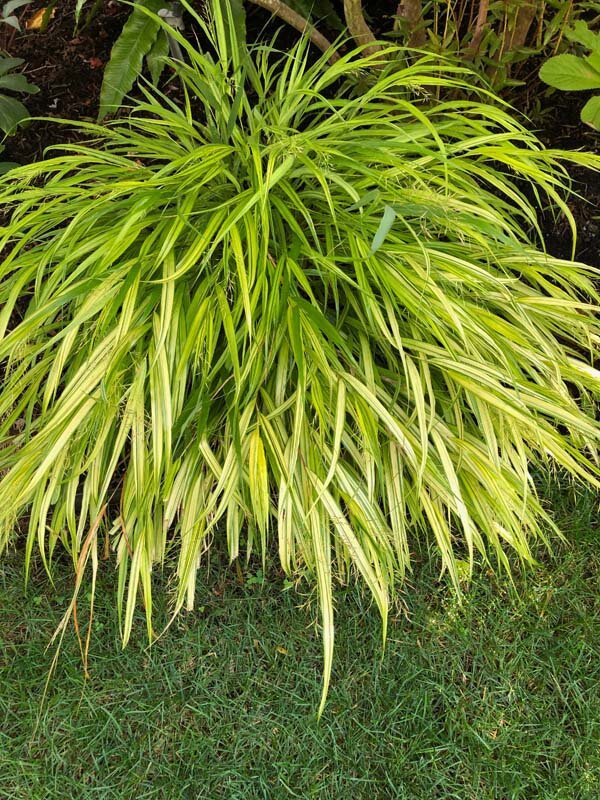Why Chartreuse?
Ipomoea batata ‘Marguerite’
Chartreuse, “A variable color averaging a brilliant yellow green” Merriam Webster.
I believe it is more than just a color.
Ten years ago (2009), I decided to officially open my business in landscape design. I had been told by a good friend that if I wanted a second career, I had better get moving before I turned 40 or life would pass me by, and I was already 43. Then came the branding piece. I didn’t even really know what branding was, but knew I had to describe to the world through my chosen business name, who I was and what I do.
Color is a drug for me. In my career as a fabric and clothing designer I played with color endlessly and more importantly, color combinations and gradients of the perfect mix of colors to create a feeling or mood. I considered not going into landscape design because I wasn’t sure there was enough color saturation and color manipulation in the job for me. It is how colors look against one another that is particularly exciting. Colors can change the way you feel in the morning when you pick out a shirt. Yellow on a cold dark rainy day keeps me warm and awake at my desk or a seafoam linen shirt on a sunny summer day makes me feel cool and sharp.
The same thing can happen when you look out into your garden or into a landscape. Grey is the predominant color we see in Seattle during the winter and long spring months as we wait to see the light again. The low light grays everything down. Gray concrete streets, sidewalks, houses of beige and blue grey and dark green conifers are a common sight in the Northwest. This is all enough to create Seasonal Affected Disorder (SAD) in Northwesterners even if you have Scandinavian roots like I do. Chartreuse is the color that has warmth, sophistication and importantly vibrates against other greens, while relating to and blending in at the same time. It pops in the wintertime and is the antidote to our often dreary winters. Chartreuse evokes joy, liveliness, enthusiasm and happiness. It is a color found in new spring growth.
The name Chartreuse also carries a certain cache’. The word is derived from the pale green French liquor made by the monks of La Grand-Chartreuse, a Roman Catholic Carthusian order living in the Chartreuse range of the French Alps. The name carries the same sophistication as some other unusual sounding colors names like, azure, cerise, puce, mauve and vermillion but it has a modern, urban edgy connotation. This is most likely caused by its appearance in the fashion, interiors and housewares markets in the beginning in 2010.
Cupressus macrocarpa ‘Wilma Goldcrest’
Like all other named colors, it is not just one color, but a range that encompasses hues from yellow/green and to lime/green. Landscape Designer Claudia West of Phyto-Studio, known for her ecological planting design, spoke at the Northwest Horticulture Society Symposium in Seattle in 2019. Her lecture pointed to the fact that in nature, most of the green we see is yellow based, not the Kelly green most of us think of when we think of foliage color. I have always loved acid yellows and greens, because they relax me and awaken my senses at the same time. Now I know why.
Here are some of my favorite useful plants that grow through the range of chartreuse:
Acer shirasawanum ‘Aurem’
Aralia cordata ‘Sun King’
Berberis thunbergii ‘Golden Nugget’
Caryopteris incana ‘Jason’
Coleus ‘Wasabi’
Cotinus coggygria ‘Golden Spirit’
Hakonechola macra ‘Aureola’
Hosta ‘Sum and Substance’
Ipomoea batatas ‘Margerite’
Robinia pseudocasia ‘Frisia’
Sambucus racemose ‘Lemony Lace’
These are some plants that do the difficult job of providing us with the chartreuse color range in winter time:
Carex oshimensis Evercolor ‘Everillo’ PPF21002
Cupressus macrocarpa ‘Wilma Goldcrest’
Chamaecyparis obtusa ‘Fernspray Gold’
Chamaecyparis pisifera ‘Filifers Aurea’
Heuchera ‘Lime Marmalade’
Lonicera nitida ‘Baggesen’s Gold’
Sedum rupestre ‘Angelina’
Taxus baccata ‘Standishii’
Taxus cupidata ‘Nana Aurescens’
Yucca filamentosa ‘Color Guard’
Hosta ‘Sum and Substance’
Hakonechola macra ‘Aureola’
Coleus ‘Wasabi’
Heuchera ‘Lime Marmalade’






